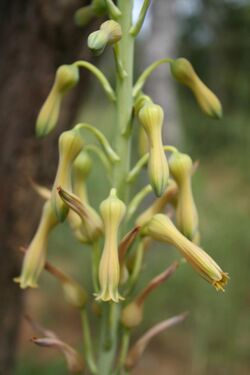Biology:Aloe buettneri
| Aloe buettneri | |
|---|---|

| |
| Scientific classification | |
| Kingdom: | Plantae |
| Clade: | Tracheophytes |
| Clade: | Angiosperms |
| Clade: | Monocots |
| Order: | Asparagales |
| Family: | Asphodelaceae |
| Subfamily: | Asphodeloideae |
| Genus: | Aloe |
| Species: | A. buettneri
|
| Binomial name | |
| Aloe buettneri A.Berger, 1905[1]
| |
| Synonyms[2] | |
|
Aloe agavifolia Tod. | |
Aloe buettneri is a species of succulent plant in the family Asphodelaceae.[2] It is found in West Africa and is known for its medicinal uses.
Description
Aloe buettneri is a succulent plant with thick and fleshy leaves arranged in a rosette. The leaves grow to about 40–80 cm long, 8–9 cm broad. The leaves are rimmed by alternating paired and solitary teeth and come together to form an underground bulb-like base making the plant appear stemless. The flowers are arranged in a loose panicle. The plant carries up to 12 branches with bulbs that vary in color from green-yellow, orange, or dull red.[3]
Genetics and breeding
The chromosome number of Aloe buettneri is 2n=14. Except for Aloe vera, all Aloe species, including Aloe buettneri, are listed by CITES, and trade in plants and plant parts is restricted. There are numerous plants present in private collections but there are no indications the species is threatened in the wild.[3]
Distribution
The natural range of Aloe buettneri is mainly West African Savannas especially Senegal, Nigeria and Togo, however, it has been found as far as Central and Southern Africa in countries such as Zambia and Malawi.[4][5] It mainly grows in these warm and dry areas. Aloe buettneri growth overlaps with the growth of Aloe schweinfurthii, which is, along with Aloe buettneri, is usually referred to as Aloe barteri Baker.[6]
Uses
Medicinal
The leaves of Aloe buettneri can be applied externally and are believed to help skin conditions such as burns, wounds, insect bites, Guinea worm sores and vitiligo.[4] In Burkina Faso the dried powdered leaves are taken to treat malaria, while in Côte d’Ivoire and Togo the roots are used for this purpose. Rheumatism is treated with leaf ash.[4]
Veterinary
In Nigeria, the leaf sap is given to cattle as an anthelmintic.[4]
Properties and research
The hydro-alcohol extract of Aloe buettneri A. Berger has anti-inflammatory, anti-ulcer and wound healing properties in rat oedema paw.[7] The methanol extract shows in vivo activity against helminthiasis caused by Nippostrongylus species in rats.[8]
See also
- Herbal medicine
- Succulent plants
- Medicinal plants
References
- ↑ Aloe buettneri was originally described and published in Botanische Jahrbücher für Systematik, Pflanzengeschichte und Pflanzengeographie. Leipzig 36(1): 60. 1905 "Plant Name Details for Aloe buettneri". IPNI. http://www.ipni.org:80/ipni/idPlantNameSearch.do?id=529285-1. Retrieved May 22, 2011.
- ↑ 2.0 2.1 "Aloe buettneri A.Berger". The Trustees of the Royal Botanic Gardens, Kew. n.d.. https://powo.science.kew.org/taxon/urn:lsid:ipni.org:names:529285-1.
- ↑ 3.0 3.1 Hans Dieter Neuwinger African Ethnobotany: Poisons and Drugs: Chemistry, Pharmacology, Toxicology (Chapman & Hall 1996) pg 7
- ↑ 4.0 4.1 4.2 4.3 Burkill, H.M., 1995. The useful plants of West Tropical Africa. 2nd Edition. Volume 3, Families J–L. Royal Botanic Gardens, Kew, Richmond, United Kingdom. 857 pp.
- ↑ JSTOR PLANT SCIENCE, Entry for Aloe buettneri A Berger [family ALOACEAE] 2000-2011 http://plants.jstor.org/upwta/3_811
- ↑ Bosch, C.H., 2006. Aloe buettneri A.Berger. In: Schmelzer, G.H. & Gurib-Fakim, A. (Editors). Prota 11(1): Medicinal plants/Plantes médicinales 1. [CD-Rom]. PROTA, Wageningen, Netherlands.
- ↑ K Metowogo, A Agbonon, K Eklu-Gadegbeku, AK Aklikokou and M Gbeassor Anti-ulcer and Anti-inflammatory Effects of Hydroalcohol Extract of Aloe buettneri A. Berger (Lilliaceae) Tropical Journal of Pharmaceutical Research Vol. 7, No. 1, 2008 pg 907-912
- ↑ Burkill, H.M., 1995. The useful plants of West Tropical Africa. 2nd Edition. Volume 3, Families J–L. Royal Botanic Gardens, Kew, Richmond, United Kingdom. 857 pp
External links
Wikidata ☰ Q286682 entry
 |

